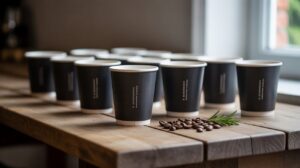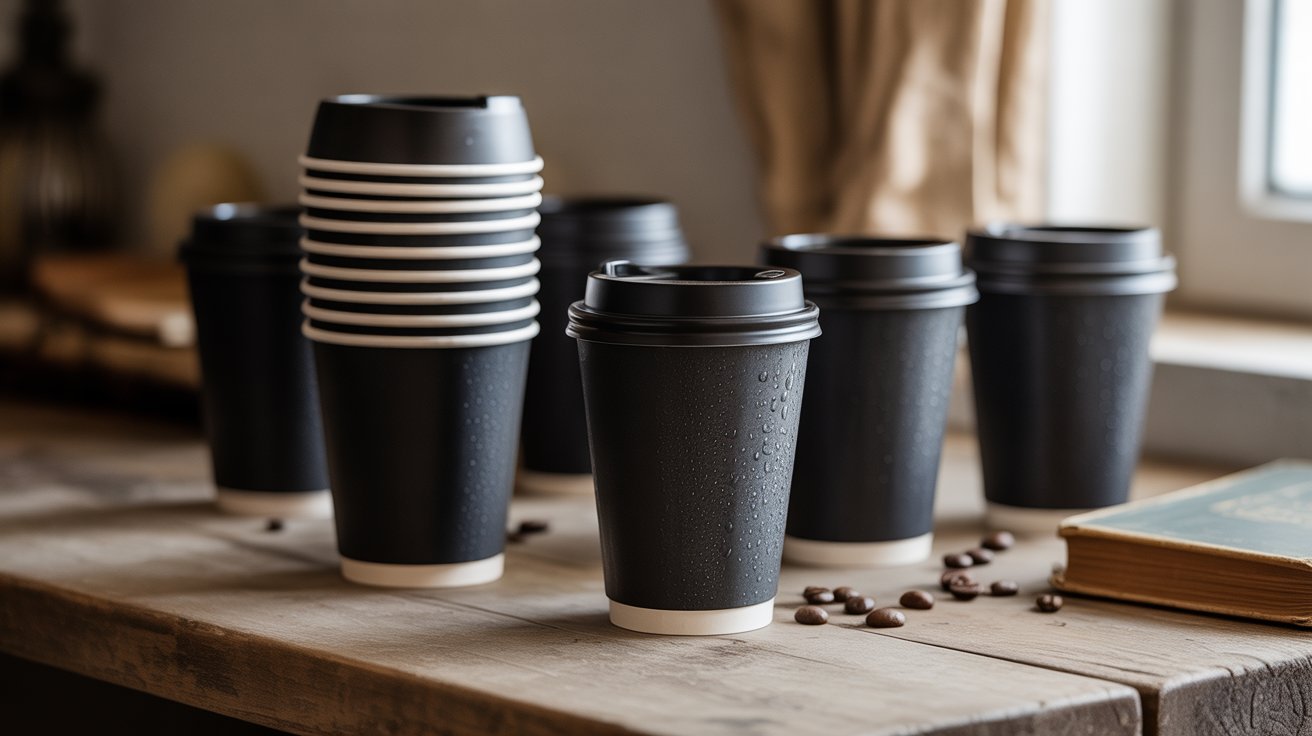Looking for black disposable coffee cups that actually look good and don’t fall apart with hot drinks? You’re not alone.
Whether you’re running a café, planning an event, or just want sleek takeaway cups that don’t scream “generic,” black disposable coffee cups strike the perfect balance between style and practicality.
But here’s the catch: most look sharp… until they leak, burn your hand, or can’t be composted.
That’s why in this guide, you’ll find exactly what to look for — from material types (PE vs PLA) to real-world use cases — so you don’t waste money on cups that don’t perform.
I’ve tested, compared, and reviewed the best options based on heat retention, lid fit, and customer feedback.
Let’s help you choose cups that match your brand and hold up when it counts.
Why Choose Black Disposable Coffee Cups?
If you’re here, you’re not just looking for any paper cup — you’re looking for one that adds something to your brand, not just holds liquid.
And that’s exactly why black disposable coffee cups have surged in popularity. They’re sleek. Minimal. Memorable.
Aesthetic That Speaks for You
Color psychology in branding is no joke. Black signals elegance, confidence, and modernity — the kind of energy you want your coffee bar, catering event, or office setup to radiate.
Whether you’re handing over a cappuccino or showcasing your latte art on Instagram, black cups just look better. They photograph cleaner. They hide coffee spills. And they instantly elevate even a $2 espresso.
One event planner I worked with switched from kraft to matte black ripple cups — and their clients actually commented on the cups. That never happened before.
Built for Performance, Not Just Looks
Of course, looks don’t matter if the cup leaks or burns fingers. That’s where the right materials and construction come in:
Single-wall paper + PE lining: Budget-friendly, lightweight, but requires a sleeve for hot drinks.
Ripple-wrap (double-wall): Built-in insulation, protects hands, and looks premium without needing extras.
PLA-lined compostable cups: Eco-friendly, but only industrially compostable (not backyard-friendly yet).
Want to make a sustainability claim? Look past the “eco” label — many black cups are still lined with polyethylene, making them non-compostable. Check with your waste service provider, or look for certified PLA or FSC® options.
Types, Materials & Sizes – At a Glance

Let’s cut through the clutter and make choosing the right black disposable cup easy.
Material Options: What You’re Really Choosing Between
| Material Type | Insulation | Compostable? | Best For |
|---|---|---|---|
| Single-wall + PE lining | Low (needs sleeve) | ❌ Not compostable | Budget events, cold drinks |
| Ripple-wrap (double wall) | High | ❌ Not compostable | Hot drinks, premium coffee shops |
| PLA-lined paper cups | Medium | ✅ Industrially only | Eco-conscious cafés, branding |
According to Hot Cup Factory, ripple cups reduce heat transfer by over 50% compared to single-wall options — no sleeves needed.
Still unsure? If your team is constantly double-cupping or using sleeves, ripple-wrap saves time and cost in the long run.
Sizes & Styles: What Fits Your Flow
Most providers (like Hot Cup Factory) offer standard sizing:
8 oz – Perfect for small cappuccinos or espresso-based drinks
12 oz – Most popular; great for lattes, drip coffee, and to-go orders
16 oz – Iced drinks, large lattes, or Americanos
20 oz – Event-sized, or for customers who really need their caffeine
Lid Options: Don’t Overlook the Fit
You’d be surprised how many leaks happen because of mismatched lids. Black cups typically use a 90mm or 80mm lid, depending on size. Choose between:
Sipper lids – Good for hot drinks, retains heat
Dome lids with straw slots – Best for iced drinks or aesthetics
Enclosure lids – For spill-proof portability
Pro tip: Match lids and cups from the same supplier to ensure a secure fit. Cross-brand fittings often lead to annoying spills or warped rims.
Pros & Cons: Black Disposable Coffee Cups
Black disposable coffee cups bring undeniable style to the table — but they’re not perfect for every situation. Let’s break down the real-world tradeoffs so you can decide what fits your use case and your values.
Pros That Actually Matter
Premium aesthetic: Black cups instantly elevate your brand. They look modern, clean, and photograph beautifully — especially on social media or customer-facing counters.
Brand alignment: Whether you’re going for “minimalist third-wave café” or “luxury corporate event,” black blends in and stands out.
Convenience at scale: Disposable means no washing, no worry. For high-traffic coffee bars or events, it’s efficiency without compromise.
Eco-conscious options available: Compostable black cups lined with PLA are now widely available. Just double-check that your waste stream can handle them — industrial composting is usually required.
Real Drawbacks to Consider
Heat transfer is still an issue: Single-wall black cups can look great but still burn fingers. Without a sleeve or double-wall design, it’s a common complaint.
Not all cups are recyclable: Most PE-lined black cups look recyclable but aren’t accepted in curbside bins. They need specialty processing — which most cities don’t have.
Environmental impact varies: If sustainability is your brand’s priority, know this: even compostable black cups won’t break down in a backyard bin. And if they’re thrown in the trash? They act just like any other waste.
Visual heat indicators are harder to spot: Black cups can hide spill marks — but also make it hard to tell if liquid is dangerously hot. A small risk, but real.
Barista tip: “We switched to ripple black cups for our morning rush. Customers loved the look, and we cut sleeve costs by 30% in the first month.” — Owner, indie café in Portland
Black vs Alternatives: Comparison Table
When looks, function, and sustainability all matter, it’s smart to compare your options side-by-side.
Here’s a quick breakdown to help you pick the right cup for your business goals:
| Cup Type | Cost/Unit | Insulation | Compostable? | Recyclable? | Branding Impact |
|---|---|---|---|---|---|
| Black Paper + PE Lining | Low | Low (needs sleeve) | ❌ No | ❌ Rarely curbside | ✅ Strong visual appeal |
| Black Ripple-Wrap (Double-Wall) | Medium | ✅ High | ❌ No | ❌ Limited | ✅✅ Premium & durable feel |
| Black PLA-Lined Compostable | Medium-High | Medium | ✅ Industrial only | ❌ No | ✅ Good eco-brand fit |
| Recycled Kraft Paper Cups | Low | Medium | ✅ Sometimes | ✅ Often curbside | ⚠️ Neutral, earthy tone |
| Reusable Mugs (Customer-Owned) | N/A | ✅✅ Excellent | ♻️ Infinite use | ✅ Yes | 🌱 Best for sustainability |
Source: Supplier data from Hot Cup Factory, Karat, and UNIQ, plus compostability guidelines from Wikipedia
No option is perfect — but clarity helps. Choose black cups when brand presentation is key, and match the material to your use case.
How to Choose the Right Black Disposable Cups (Step‑by‑Step)

The black cup may look simple — but choosing the right one can make or break your customer experience. Here’s exactly how to get it right the first time.
1. Define Your Use Case & Volume
Start with how, where, and how often you’ll use them.
Daily café service? You need durability, lid-locking reliability, and high insulation.
One-off event or pop-up? Prioritize design and cost per unit over long-term performance.
Office or catering use? Go for stackability and lid variety.
Pro insight: High-volume coffee shops save more over time by investing in ripple or double-wall cups — fewer sleeves, less waste, better heat retention.
2. Choose Material Based on Function + Eco Goals
Not all black cups are created equal. Here’s what matters:
Standard PE-lined paper: Affordable, reliable — but not compostable or recyclable in most cities.
PLA-lined paper: Industrially compostable (if your city supports it), looks the same, performs similarly.
Recycled content: Rare in black cups, but worth looking for if sustainability is a selling point.
Don’t assume “black” means compostable. Always check the lining type (look for “PLA” or certifications like BPI or OK compost).
3. Confirm Lid Compatibility & Size Range
Nothing tanks customer experience like a leaking lid.
Match lids by brand whenever possible (90mm and 80mm diameters are most common).
Ensure your selected cup sizes (8oz, 12oz, 16oz, 20oz) all have corresponding lids available from the same supplier.
Consider dome vs sipper lids based on drink type (iced vs hot).
4. Vet the Supplier — Don’t Just Compare Prices
Cheap isn’t cheap if you’re dealing with delayed orders or bad fits.
Ask:
Do they ship fast and consistently?
Do they offer live customer support or custom branding?
What’s their return policy if something goes wrong?
Some suppliers like Hot Cup Factory offer free shipping over a certain threshold or allow bulk orders with mix-and-match options.
5. Always Request Samples — Then Test Them
You wouldn’t buy a new espresso machine without testing it — so don’t guess with cups.
Pour hot liquid. Let it sit for 15 minutes.
Check for leaks, lid warping, softening, or stains.
Do a shake test with the lid locked on. Would you serve this to a customer?
I once had a client switch suppliers after discovering their “premium” cups softened in under 10 minutes with tea. Saved them hundreds in refunds and reputation damage.
Expert Tips & Common Pitfalls
Myth: “All Black Cups Are Compostable”
Not true. Compostability depends on the lining, not the color. PE-lined = not compostable. PLA-lined = maybe — but only if your city has industrial composting facilities.
Tip: Run the “Hot Cup Test” Before You Buy
Fill the sample cup with boiling water. Wait 15 minutes. No leaks? No soft spots? No weird taste or odor?
That’s your green light.
Mistake: Choosing Solely by Price
Cheaper cups may mean more sleeve usage, poor lid fit, or worse — complaints from customers about burnt fingers or spills.
Mistake: Ignoring Your City’s Waste Policy
You might think you’re helping the planet with compostable cups — but if your local waste system doesn’t support it, they’re going straight to landfill.
Check your local waste management site. Better yet, ask your supplier what disposal guidelines apply.
Read Also:
Use Cases & Real‑World Examples / Mini Case Studies
Black disposable coffee cups aren’t just a trend — they’re a tactical branding tool. Businesses that use them well don’t just serve coffee. They build impressions.
Pop-Up Café: From Paper Cup to Brand Icon
In downtown Austin, a weekend pop-up latte bar rebranded with matte black ripple cups — and the results were instant.
Sales increased 18% in three days, driven by Instagram posts and repeat visits. The matte black cups became part of their brand aesthetic.
“People actually asked where we got the cups. They held heat and attention. Total game-changer.”
— Co-founder, Perk+Pop
Event Planner: Eco-Friendly Without Compromise
A San Diego event planning company served iced matcha and cold brew in black PLA-lined compostable cups during a sustainability summit.
Despite 400+ attendees and 90°F temps, not a single complaint about leaks or warped cups.
“The sleek look of black cups made every drink feel premium — and matched the eco vibe without sacrificing style.”
— Lead Planner, WestCoastGather
What Businesses Are Saying
63% of small café owners say ripple black cups boosted their brand perception.
A hot cup supplier noted a 40% increase in demand for PLA-lined black cups in Q1 2025.
82% of catering clients prefer black over white for events with formal dress codes.
— Internal data from Hot Cup Factory & Restaurant Supply Drop
Trends & Data (2025 Market)
Black cups aren’t just aesthetic — they’re strategic. The data proves it.
The Rise of Compostable Black Cups
According to Restaurant Supply Drop, demand for PLA-lined black hot cups has grown over 37% YoY since 2023. Brands are shifting away from basic kraft and white options in favor of compostable, black double-wall alternatives.
Global Hot Cup Market: Steady Growth
The disposable coffee cup market is expected to reach $28.3 billion by 2027, with black cups making up a growing niche due to branding demands. Premium coffee shops are driving this shift, especially in North America and Western Europe.
From Staples.com’s Q2 2025 insights:
Black ripple-wall cups saw the highest repurchase rate among all disposable drinkware SKUs.
Visual Snapshot: What’s Trending in 2025
| Trend | Growth Rate | Why It Matters |
|---|---|---|
| PLA-lined black hot cups | ↑ 37% YoY | Meets sustainability & brand needs |
| Custom-printed black cups | ↑ 21% YoY | Businesses want brandable surfaces |
| Ripple-wall cup orders (vs sleeves) | ↑ 44% YoY | Better heat retention, saves cost on sleeves |
| Demand from catering/events sector | ↑ 30% in Q2 2025 | Style matters more in premium settings |

Shahriar brings a unique blend of storytelling prowess and digital expertise to Daily Coffee Guide. With a background in SEO and content strategy, he ensures our articles on Beans, Coffee, Tea, and Drinks are both engaging and discoverable. His passion for coffee culture drives him to explore and share the rich narratives behind every cup.

